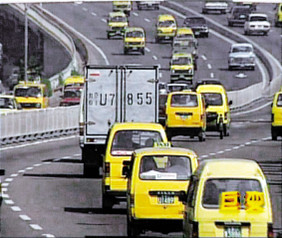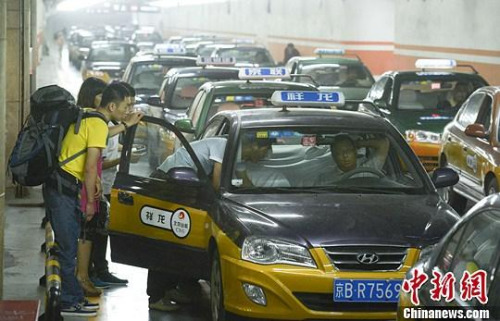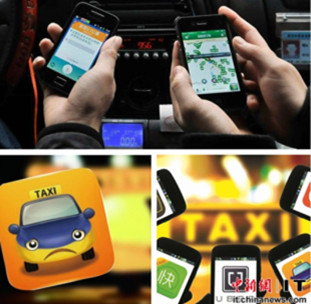Review of the development of taxis in China: from "face-to-face" to "Internet +"
On the afternoon of the 10th, the Ministry of Transport publicly solicited opinions from the public on the new regulations on taxi reform. Including dividing taxis into cruise taxis and reserved taxis, and incorporating new formats such as "special cars" into the category of taxi management, etc., China’s taxi development has also ushered in new changes.
From the "high-end rental" that is out of reach of the common people to the "era of face-to-face" that beckons to stop, from allowing private capital to enter to the Internet era to give birth to the "special car" format… As the new round of taxi reform kicks off, China News Service reporters take you back to the "past life" and "present life" of China’s taxi industry for more than 100 years.
Before the reform and opening up: "High-end" taxis beyond the reach of the common people
In China, the two-wheeled rickshaw (also known as the "rickshaw") in Mr. Lao She’s "Camel Xiangzi" may be the first thing people think of when they mention the "past life" of taxis. In fact, as early as the beginning of the last century, car rental services began to appear in many cities in China.
In 1903, taxis entered China, and Harbin became the first city in China to have taxis. Before liberation, although there were more and more taxi companies in some cities in China, each company had very few vehicles. The main reason was that at that time, because cars needed to be imported, the purchase cost was too high, even for used cars.
After the founding of New China, the taxi industry declined, and buses and bicycles gradually increased. In 1956, the entire taxi industry across the country implemented public-private partnerships.
In Beijing, Capital Automobile was established in 1951 to solve the problem of vehicle reception for foreign affairs. According to the "glorious history" column of the official website of the Shouqi Group, the Capital Automobile Company was approved by Premier Zhou Enlai at that time, and the name was personally delineated.
During the Cultural Revolution, the taxi industry shrank sharply. In the early 1970s, all kinds of foreign affairs activities increased in Beijing and big cities such as Shanghai and Guangzhou, and taxis appeared on the streets again.
In general, however, for a long time after the founding of New China, many taxis served foreign guests. Take Guangzhou as an example. Taxi is specially responsible for receiving foreign heads of state and senior officials who come to Guangzhou, foreign businesspeople attending trade fairs, overseas Chinese, Hong Kong and Macao compatriots, etc. It is known as Guangzhou’s "state guest fleet" and requires foreign exchange certificates to ride.
In those days, the daily transportation methods of city residents were mainly bicycles and buses.

The 1980s and 1990s: the "era" of taxis reaching ordinary people
After the reform and opening up, China’s taxi industry has also ushered in a golden period of rapid development, and the development of taxis in various cities in China has gradually become unique.
In the early 1980s of the reform and opening up, a number of state-owned and collective taxi companies were established in Beijing, but most of the models were mainly high-end imported cars such as Toyota and Crown, and most of them were mainly used to transport foreigners and foreign enterprise personnel.
In the memory of old Beijingers, taxi drivers in that era were enviable high-income class, and driving taxis even became a status symbol. According to an old taxi driver, at that time, the taxi fare of 0.8 to 1.2 yuan per kilometer was in the eyes of ordinary people.
The turnaround came in 1992. Since then, in order to solve the difficulty of hailing a taxi, Beijing has proposed the goal of "five taxis can be parked with one wave of hands" and allowed private capital to enter the taxi market. A large number of private enterprises have joined, and drivers find taxi companies to buy cars. All operating expenses are taken care of by the drivers themselves, and the management fee is paid monthly. The "share money" of Beijing’s taxi industry is born.
By 1994, there were more than 1,400 taxi companies in Beijing, and there were as many as 60,000 taxis. In the "golden three years" of Beijing taxi development, although there were management fees, taxi drivers’ income was still high.
During this period, a miniature bread taxi called "noodle" by Beijing residents appeared in the streets and alleys of Beijing. Due to its low price and convenience, the "noodle" became popular in Beijing, and taxis began to enter the lives of ordinary people. Because the yellow-painted noodle is all over the capital, Beijing residents also call it "yellow bug".
In the context of the explosive development of the market, since then, due to the intense competition in the market, taxis have been competing with each other for territory, detouring passengers, refusing to carry passengers, and carpooling, etc., and the high-income aura of taxi drivers has gradually disappeared.
Since 1994, Beijing has controlled the number of taxis, and for the next 20 years, the number of taxis in Beijing has remained almost constant at more than 60,000.

From the late 1990s to the beginning of the new century: Industry changes and reforms go hand in hand
With the deepening of reform and opening up, the rapid development of the economy has also accelerated the development pace of the urban taxi industry. Take Beijing as an example. Since 1994, the red Xiali has come into people’s sight, and the "face" has gradually been phased out. By 1998, the "face" has completely withdrawn from the Beijing market, and the taxi price has also been unified into Xiali at 1.2 yuan per kilometer and Fukang and Jetta at 1.6 yuan per kilometer. The logo color of Beijing taxis has changed from yellow to red.
Although the taxi "reshuffle" in Beijing welcomed Xiali and Fukang models, Shanghai, Guangzhou, Shenzhen and other places during the same period have been replaced by Santana.
In 2004, Beijing taxis began a new round of upgrading. Beijing Hyundai’s Sonata and Elantra became the main models of the city’s taxis. The taxi logo color once again completed the transformation from red to suit color. In the round of "reshuffle" ten years ago, Beijing taxis also entered the era of unit price of 2 yuan/km.
At the same time as the color change twice, since the late 1990s, Beijing has also begun to rectify the taxi industry, and drivers and taxi companies have also ushered in a major adjustment in their interests.
From 1992 to 1996, in most taxi companies in Beijing, the driver was the real investor, but the company was the owner. At that time, only from the bicycle, the driver earned more than the company, and the taxi driver was considered a high earner.
In 1996, the Beijing Taxi Administration issued the "Notice on Strengthening the Contract Management of Enterprise Operation Tasks", and taxi companies implemented contract management. At the same time, the contract fee (part money) for taxi drivers was also increased to 4,000 to 5,000 yuan per month. The contradiction between taxi drivers and taxi companies began to emerge.
After entering the new century, Beijing’s taxis entered the stage of merger and reorganization, and the number of taxi companies has increased from more than 1,000 to more than 200 today.

After 2010: Revolutionary changes in the taxi industry in the Internet age
In recent years, the phenomenon of taxi-hailing difficulties, refusal to take passengers, and driver strikes in some cities has gradually brought to the fore the contradictions and problems accumulated by China’s taxi industry for a long time. At the same time, the new travel mode brought by the Internet has also profoundly changed the ecology of the traditional taxi industry.
The emergence of mobile phone ride-hailing software has made it unnecessary to go to the road to hail a taxi, and the emergence of new rental models such as private cars and ride-hailing has made the concept of taxis no longer limited to rental companies. Taxi drivers may also be the temporary identity of a private car owner.
While the market has ushered in "revolutionary" changes, how to reform the traditional taxi industry and how to regulate the emerging business has attracted much attention from the society, and the reform of the taxi industry has once again reached a historical juncture.
On October 8, 2015, the Shanghai Municipal Transportation Commission issued China’s first special car platform qualification license to "Didi Kuaidi" – the online car rental platform operation qualification license, and the legalization of special cars broke the ice first in Shanghai.
Two days later, on October 10, the Ministry of Transport issued the "Guidance on Deepening Reform and Further Promoting the Healthy Development of the Taxi Industry (exposure draft) " and the "Interim Measures for the Management of Online Booking Taxi Business Services (exposure draft) " for a one-month public consultation.
According to the plan, new formats such as "special cars" will be included in the scope of taxi management, and taxis will be divided into a diverse service system in which cruise taxis and reservation taxis coexist with new and old formats, and classified management, dislocation development and differentiated management will be implemented.
In addition, including the dynamic adjustment of the total amount of taxi scale; the free use of operating rights and a limited period; the part of the money should be determined and made public through negotiation; online car-hailing operators, vehicles and drivers implement licensing management; private cars are not allowed to access the special car platform; carpooling cannot be for profit… In the Internet age, a new round of reform plans for China’s taxi industry has finally emerged.